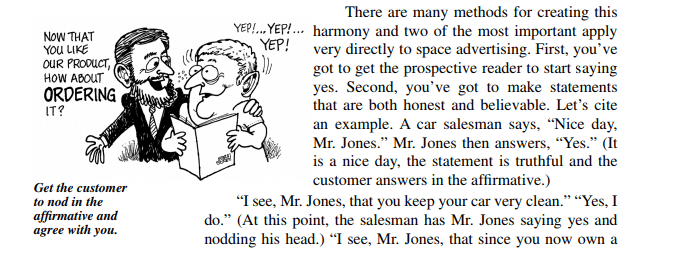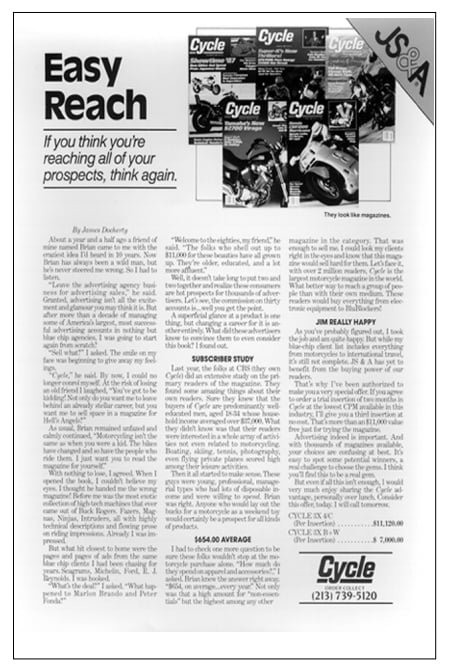Joseph Sugarman is one of the most epic copywriters that’s ever lived.
He launched his direct mail agency JS&A Group by writing ads by hand and has no shortage of amazing feats in advertising.
Let me explain…
He once sold a used plane for $240,000 that was valued at $190,000 through one magazine ad.
He wittily told readers that he’d pay them $10 for every grammar mistake they found in ads. Hint: they found none.
He was one of the first advertisers to accept credit cards over the phone, pioneering a lot of the direct advertising we see today.
And Joseph did it in a humorous way that showcased his personality and unique writing style.
If you haven’t read his book The Adweek Copywriting Handbook, you need to get your hands on it now.
It’s easily the best material I’ve ever read on copywriting and transformed me as a writer.
Seeing as it’s in excess of 300 pages, I’ll save you some time and sum up some of Sugarman’s main writing strategies ahead if you keep reading. 🙂
The first sentence should lead to the next sentence and so forth
All of the elements within an ad, whether it’s direct mail, a landing page, or other material, are to get the customer to read the first sentence.
If they don’t read the first sentence, how will they read the second? How will they reach the end where you ask for the sale?
They won’t.
That’s why it’s extremely important to make sure that the introduction to any ad is irresistible.
It needs to be interesting, unique, and, most importantly, short.
Joseph Sugarman believed that the first sentence of your copy should be short because it’s easier to read and creates fewer obstacles.
This sucks the reader into the copy, and they can’t help but flow through the remaining ad.
Next time you’re writing copy for any advertisement, try to make the first few sentences as short as possible.
You can also fragment sentences. This means breaking them up into chunks. You might irritate some grammar scholars, but customers won’t mind.
Master strategies and more in my copywriting bootcamp.
Every word has emotion and meaning behind it
Every word you use matters. They all tell a story and have an emotion behind them.
For example, what do you feel or think of when I say the following words?
- Florida
- Red wine
- Italy
- Ferrari
- Rolex
You might’ve thought of hot weather and oranges when thinking of the state of Florida.
Red wine might bring up memories of dinners with your family.
Italy can make you think of pizza, pasta, and soccer.
You get my point.
Every word is going to paint a picture in the customer’s head. Not only that but changing a single word can often increase the conversion and response rate of an ad itself.
In fact, he mentions this in The Adweek Copywriting Handbook:

Sell a cure, not a prevention
Joseph Sugarman believed in selling a cure and not a prevention.
Most customers aren’t interested in preventing something from happening but rather in curing an existing problem.
The average person isn’t thinking about stopping a problem that might happen in the future, anyways.
However, when a customer is experiencing turmoil, they will seek a fix and be more likely to purchase a product or service which does so.
This is why you don’t see weight loss pills aimed at preventing weight gain from occurring, for example.
Instead, you see similar products that claim they will make the customer lose weight, get toned, and get a flat stomach in no time.
Furthermore, a customer that is advertised a prevention-oriented product won’t be as likely to spend as much.
Why is this? Simply because there’s no urgency.
But if a customer stepped on the scale and saw they gained 20 lbs over the winter, that weight loss pill now looks a lot more appetizing.
Since they desire it more, the customer will also be willing to spend more to obtain the “cure.”
Get the customers saying “yes”
If you get the customer saying “Yes” while reading an advertisement, they will be more likely to say yes to the sale.

You can do this by asking relevant questions or making agreeable statements throughout the ad.
This gets the customer in the headspace of acceptance, which is exactly where you want them when you tell them to buy later on.
Joseph Sugarman also called this harmony.
The customer needs to harmonize with the ad.
As soon as they shake their head in disagreement or not understanding what you’re saying, the sale is lost.
A great example of this is when Cycle magazine sent an advertisement to Joseph Sugarman himself.

But here’s the catch…
They used his EXACT design and copy style to grab his attention.
While it could’ve greatly backfired, Joseph found it entertaining and bought ad space in their magazine.
Heck, the best copywriters can still be persuaded and harmonized with an advertisement!
Never sell a product, sell a concept
Concept, brand, position. The list goes on.
These words can be used interchangeably, but the concept(No pun intended), remains the same.
You never want to sell a product or service. Rather you want to sell a bigger idea about the product.
This is normally done by elaborating on the benefits of the product rather than its features.
So many businesses, unfortunately, only write copy that explains the factual pieces of information about an item.
I’m talking about sizing, materials, colors, etc.
That’s cool, but customers don’t really care.
For example, Joseph Sugarman once wrote an ad for a smoke alarm speaking about how it was the “nose” of your house that smelled out trouble before it happened.
That’s a concept.
You can see the same thing being done by every luxury brand in the world.
Look how BMW uses this strategy in an advertisement for its i8 model:

Everything from the image to the headlines and copy makes it seem like a futuristic vehicle. Once again, a concept or bigger idea is used.
There needs to be a logical flow in the ad
The copy of an ad needs to flow in a logical order.
This means that the individual sections go after each other in a way that makes sense.
Furthermore, you need to answer questions in a logical order as the customer would ask them.
I recommend creating a flowchart or skeleton of your project before you begin writing.
This will allow you to map out all of the major points, questions, and objections you will be covering.
You can then rearrange them to make the most logical sequence and to align with what customers are thinking.
Every good ad is an emotional outpouring of words, feelings, and impressions
Yes, there are logic, sequence, and similar aspects of advertising.
But most importantly, every great ad is based on emotion.
This is because every customer experiences emotions when they need a problem solved.
And that’s exactly what your product does: it solves a problem.
This is why copywriters need to focus on writing copy around experiences, feelings, and thoughts related to what they sell.
While customers will commonly justify a purchase with logic, it’s based on more primitive and deeper emotions.
If you can align ads with these primal feelings and desires, you’ll have no shortage of success as a writer.
With that being said, here are the main takeaways from today’s article:
- The goal of the first sentence is to make the customer reader the second sentence and so forth. Use short and choppy sentences to make advertisements easier to digest.
- Every word you use in an advertisement paints a picture in the mind of consumers. Carefully select words based on how you want customers to feel while reading your copy.
- Position your product as the cure to a situation rather than a prevention. You can charge more for the product and there is increased desire when a problem needs to cured.
- Use statements and questions that will get customers nodding their heads in agreement. This will make them more accepting to the sales proposition later.
- Position the product you’re advertising around a bigger idea or concept. Look back at the BMW example to see this in action.
- Ensure the order of your advertisement and copy has a logical sequence.
- Focus on creating advertisements around emotions and experiences since these drive purchasing decisions to begin with.
Explore my online courses to learn about copywriting, freelancing, and more.














